- Joined
- Mar 27, 2016
- Messages
- 825
Thank you. I did not know that they had to be pastel. That’s good to know. I have read the definitions in books and admired several IRL, but I don’t think I’ve ever seen the AGL definition. They are such beautiful gems. Padparadcha has always been one of my favorites.I think they have to be pastel in order to qualify as a padparadcha. We all definitely like what we like though.
@corundum_conundrum Thanks for that insight! I didn't know that about ovals, though I did observe a similar dark spot at a jeweler while looking at other sapphires IRL.
@chrono My SO and I both agreed that it'd be okay for a gem to not come back pad if we love the color, but we just don't want to pay pad prices for something that's not, and we want to pay fair pink prices if that sapphire is pink. As for design, current thinking is either a 3 stone or standalone with a pave band, with a interesting basket (is that the right term for the part holding the gem?), e.g. filigree or lined with melees. I originally really wanted rose gold, but I've seen some beautiful pads with white gold, and I've also seen some beautiful two-tone rose/white gold rings.
@Arcadian see above - we're okay with it not being pad, but just want to make sure we're not overpaying if it's not. The seller explicitly said that the stone may or may not come back as a pad so I doubt they would cover the cost of a cert.
@LilAlex thank you! I've read about pads washing out against flesh but I hope I can find one that pops.
After everyone's feedback on the cut and looking at the gem in all sorts of different lighting (and not being unable to unsee those shadows), I think my SO and I will likely send this one back (haven't shipped out to AGL yet). It's pretty, but as a poster earlier said, it doesn't make our hearts sing. The hunt continues.
That Finewater one made my jaw drop! It does look quite orange on my screen, but I can see pink. My SO reached out to ask about an AGL cert, and Gary said AGL identified the gem as orangeand he disagreed, hence the Lotus Gem Lab cert. What do you all think? Is Lotus Gem Lab a respectable lab? Is this worth the asking price without a AGL cert?
Here's the LGL cert as a PDF - you can zoom in to get a closer look at the gem: http://lotusgemology.com/media/reports/pdfs/9805-9241S.pdf
Thank you. I did not know that they had to be pastel. That’s good to know. I have read the definitions in books and admired several IRL, but I don’t think I’ve ever seen the AGL definition. They are such beautiful gems. Padparadcha has always been one of my favorites.
If AGL doesn't accept it as a padparadcha, it's not worth 15k to me. That's a giant chunk of money.@corundum_conundrum Thanks for that insight! I didn't know that about ovals, though I did observe a similar dark spot at a jeweler while looking at other sapphires IRL.
@chrono My SO and I both agreed that it'd be okay for a gem to not come back pad if we love the color, but we just don't want to pay pad prices for something that's not, and we want to pay fair pink prices if that sapphire is pink. As for design, current thinking is either a 3 stone or standalone with a pave band, with a interesting basket (is that the right term for the part holding the gem?), e.g. filigree or lined with melees. I originally really wanted rose gold, but I've seen some beautiful pads with white gold, and I've also seen some beautiful two-tone rose/white gold rings.
@Arcadian see above - we're okay with it not being pad, but just want to make sure we're not overpaying if it's not. The seller explicitly said that the stone may or may not come back as a pad so I doubt they would cover the cost of a cert.
@LilAlex thank you! I've read about pads washing out against flesh but I hope I can find one that pops.
After everyone's feedback on the cut and looking at the gem in all sorts of different lighting (and not being unable to unsee those shadows), I think my SO and I will likely send this one back (haven't shipped out to AGL yet). It's pretty, but as a poster earlier said, it doesn't make our hearts sing. The hunt continues.
That Finewater one made my jaw drop! It does look quite orange on my screen, but I can see pink. My SO reached out to ask about an AGL cert, and Gary said AGL identified the gem as orangeand he disagreed, hence the Lotus Gem Lab cert. What do you all think? Is Lotus Gem Lab a respectable lab? Is this worth the asking price without a AGL cert?
Here's the LGL cert as a PDF - you can zoom in to get a closer look at the gem: http://lotusgemology.com/media/reports/pdfs/9805-9241S.pdf
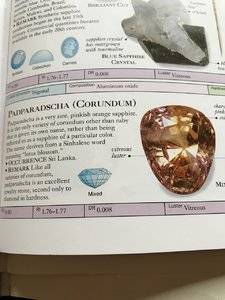
Thank you for the link! The two books I pulled out of my library mentioned pinkish orange/orangey pink, but not tone or saturation for some reason. The book I have by Antoinette Maitlins does say that “true padparadscha should exhibit a pink and orange color simultaneously.” The Smithsonian book by Cally Hall I have has a photo of a pad with this phenomenon. Here is the photo. I’m certainly no expert. I’m just a hobbyist. I’m just going on what I’ve seen IRL and in books. It sounds like the industry may standards have changed.
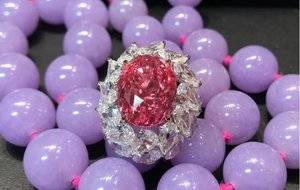
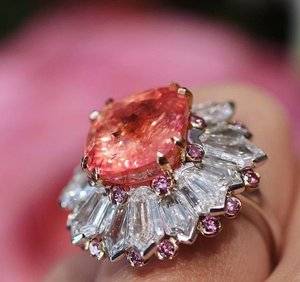
Both are beautiful!I'll post what I think are examples of orangey pink, and pinkish orange.
To me, this one is a more pinkish pad....on my monitor, I would describe it as watermelon or fruit punch color. But who knows a lab might say it's only a pink sapphire.
And this one a more orangey pad...I would describe this color as coral.
Any darker, the stones would start to look like some Songea sapphire....not good. Saturation wise, I don't think more saturated stones than these occur naturally. Lighter and less saturated ones would appear peach.
It looks like I was interpreting two distinct color zones, while others are interpreting a blend.
In my experience, pads used to be accepted by labs only up to medium tone, medium to good saturation until a few years back.
Then at some point something changed and vividly saturated pads started popping up not only classified as padparadscha by all major labs, but also sold as such and at a vast premium over the mediums (just have a look at the past few years of Christie's/Sotheby's catalogues and/or any bigger dealer at a large gem show).
Side note:
While there is some orange (barely perceptible, it's more colour contamination than an under/overtone), I don't think any honest lab should classify this as anything other than an orangish pink sapphire. I'd never pay for it as a pad, but large portions of the global market would.
That is a very, very, very rare occurrence in natural sapphires and (for me) definitely one of the paragon pad colours.
Oh, also - padparadscha prices have gone through the roof in the past year or so.
Thank you for your response. This is really informative. I finally think I understand.About that... Ideally, the stone should be mixed/blended. If it has a pink body colour with one small patch of clearly outlined orange, for example, it wouldn’t really be fair or nice to call it a padparadscha.
The funny thing is that this can be rectified by cutting; a colour zoned orangish pink sapphire can be made into a padparadscha by recutting if the orange is near the culet but it’s crazy risky (colour loss and uncertain results, possibly or even likely worse off than where you began) so it isn’t normally done.
What I’m referring to though is really distinct colour zones - almost outlined ones, visible even at a glance. There’s a limit to that too; if the stone on the other hand has zones of predominantly one and the other colour but the brilliance pattern blurs the lines between where one begins and the other ends, then it’s fair to say it’s a blend and call it a pad if the colours fit.
A perfect blend throughout is almost impossibly difficult at any price at all (had enough orders for “10/20 carat perfect padparadscha” in my time to know that that’s a joke and a waste of time).
Thank you for your response. This is really informative. I finally think I understand.
If anyone is interested in an example of a parti colored orange and pink sapphire, gemfix has one. GRS certifies it as a pinkish orange sapphire while GIA calls it a parti colored sapphire. @Frost, your comments on the difficulties of cutting this type of sapphire made me think of this stone.
https://gemfix.com/gems/sapphire-pink-13-502
That does sound frustrating. I realized after educated yesterday that I actually love orange and pink parti colored sapphires, not padparadschas. That should bring down the price point a couple of notches.Glad to help.
I'm more sick and tired of getting offered "padparadschas" than most on here - it's a facepalm at least a few times a day/week for me.
That is beautiful and exactly what I want. That would definitely fall into the big anniversary or birthday gift category though. It would be nice if I could just click the add to cart button!If anyone is interested in an example of a parti colored orange and pink sapphire, gemfix has one. GRS certifies it as a pinkish orange sapphire while GIA calls it a parti colored sapphire. @Frost, your comments on the difficulties of cutting this type of sapphire made me think of this stone.
https://gemfix.com/gems/sapphire-pink-13-502
Both are beautiful!
Exactly! Call it anything! My sweet grandmother said “I don’t know what it is, but it’s beautiful”, when my mom gave her a gift one time and she wasn’t sure what it was. I always think of that when I see a gem I love, but can’t identify it or don’t have a clue about what to call the color.haha I was thinking "You can call it anything you want including murky mud but if you give it to me I won't say no to it!"
They are gorgeous! Especially the first one!
what about this one?
https://gemfix.com/gems/sapphire-pink-13-499
it is close in appearance to the one you were originally interested in, it faces up larger than the finewatergems one. It may not be designated a pad by AGL (AGL is a bit stricter than GIA), but it doesn't command a sky high price tag either.
If anyone is interested in an example of a parti colored orange and pink sapphire, gemfix has one. GRS certifies it as a pinkish orange sapphire while GIA calls it a parti colored sapphire. @Frost, your comments on the difficulties of cutting this type of sapphire made me think of this stone.
https://gemfix.com/gems/sapphire-pink-13-502
So what makes this a parti? Is it because the orange is so well defined that the pink is only visible around the edges?
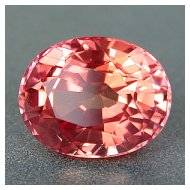

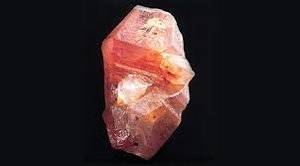
The second photo looks straight up salmon to me. Is that what pads are supposed to be? I think when I go to a gem show later this month, I am going to ask every vendor to show me their padparadscha. I really need to see what they look like in person.It's a stone with distinct zones of color that neither mix naturally, nor were they made to mix enough through cutting (sometimes it just isn't possible, it looks like they've tried but sometimes you just can't).
Without seeing the stone in person, I'd take a guess that the body mostly contains orange, with possibly one or two zones of other colors reflecting on the edges.
Additionally, those zones aren't really pink. The stone has a purplish tone - and pads should not have any at all according to all traditional definitions and all major lab guidelines. This is most likely the main reason why the labs didn't give it the pad report to begin with (with the added reason being the color zones as they are).
Compare that stone to the following examples - random images pulled off Google for the search query "perfect padparadscha":
All of the above stones have their colors sufficiently 'mixed' and of the correct hues for most labs to give them that classification. Notice the smooth transitions? The "blended" colors? Pink/orange/yellow as primary components in various mixes.
The colors themselves won't always be blended flawlessly and you will be able to notice small flashes of pink or orange or yellow here and there, but what really counts is the overall impression. Does the stone, overall, have an impression of a mixed pink/orange/yellow (at least two of those) in it? If yes, chances are it can be called a pad. If not, and there are distinct zones face-up or there's brown or purple admixture, then most likely not.
Generally speaking about color zones; if you have a sapphire to try this on, you can pretty easily see color zones if you just put the stone onto a white plate and fill that plate with water (or glycerine, or any similar clear liquid - the closer the liquid RI to corundum, the better). You lay it on the plate face down, completely submerged, take the plate out to daylight et voila - you'll see where the color zones are in the stone very clearly in a way that's impossible to see in air or face-up. It'll look like patches, strips, lines or swathes of color in some places, almost none in others. Sometimes you'll see a completely unexpected third color that doesn't show up face up at all and only serves as a very minor modifier in the final composition of hue.
This doesn't mean anything in practice most of the time and it doesn't impact the price if there's nothing to see face-up, but it does give cutters an idea of what they're working with, for example (and it can be fun to observe).
Another note on color zones: 9 times out of 10, they will be much more visible in an enlarged, motionless photo than in person. DSLRs show a single moment, while the eye sees the whole thing in motion/blur so it kind of blends in more to the eye in person than it does like this over the Net (there are exceptions to this also though).
The second photo looks straight up salmon to me. Is that what pads are supposed to be?